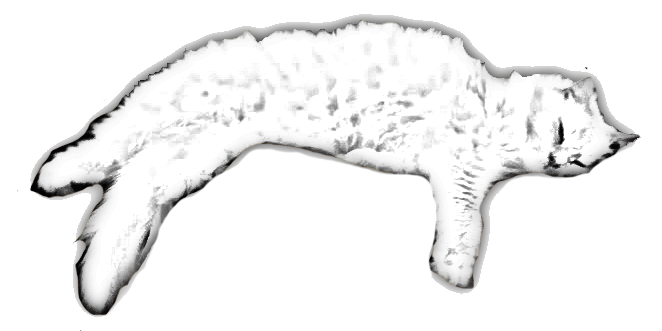Did you know that indoor cat breeds boast a wide array of exquisite coat patterns? From striking spotted coats in Bengal Cats to majestic tabby patterns in Maine Coons, these feline beauties are a sight to behold.
With elegant color-point coats in Siamese Cats and beautiful bicolor patterns in Ragdolls, there's something for every cat lover.
And let's not forget the unique ticked coats of Abyssinians.
Join us as we delve into the fascinating world of indoor cat breeds and their stunning coat patterns.
Bengal Cats: Striking Spotted Coats
We often marvel at the striking spotted coats of Bengal cats. These feline beauties possess a unique and captivating coat pattern that resembles that of their wild ancestors, the leopard.
The striking rosette markings found on their fur create an exotic leopard-like appearance that sets them apart from other domestic cat breeds. These rosettes are formed by a contrast in color, with darker spots outlined by a lighter shade, giving the coat a three-dimensional effect. The spots can vary in size, from small and tightly packed to larger and more spaced out, adding to the visual appeal.
The intricate and detailed coat pattern of Bengal cats is a testament to their wild heritage and adds to their allure as beloved companions.
Maine Coons: Majestic Tabby Patterns
While discussing exquisite coat patterns found in indoor cat breeds, let's now explore the majestic tabby patterns of Maine Coons. Maine Coons are known for their large size and stunning tabby coats, which come in various patterns and colors.
Here are some grooming tips and a brief history of this beloved breed:
- Grooming Tips:
- Regular brushing: Maine Coons have long, thick fur that requires regular brushing to prevent matting and keep their coat healthy.
- Bathing: Although Maine Coons are generally clean cats, an occasional bath can help keep their fur clean and reduce shedding.
- Nail trimming: Regular nail trimming is essential to prevent painful ingrown nails and furniture damage.
- History of the Breed:
- Origin: Maine Coons are believed to have originated in the United States, particularly in the state of Maine, where they were valued for their hunting skills and ability to withstand harsh weather conditions.
- Myth and legends: Some legends suggest that Maine Coons are the result of a crossbreeding between domestic cats and raccoons, but this is biologically impossible.
- Recognition: Maine Coons were officially recognized as a breed in the late 19th century and have since become one of the most popular cat breeds worldwide.
Maine Coons' majestic tabby patterns, combined with their gentle and sociable nature, make them an enchanting addition to any cat-loving household.
Siamese Cats: Elegant Color-Point Coats
Siamese cats exhibit elegant color-point coats, characterized by their distinct contrast between the lighter body and darker extremities. The origins of this unique coat pattern can be traced back to ancient Siam, now known as Thailand. Siamese cats were highly revered in their homeland and were even considered sacred.
It wasn't until the late 19th century that Siamese cats were introduced to the Western world. Today, Siamese cat breed standards place great importance on the coat color. Show cats must have a clear and even coloration, with the extremities being a deep, rich color. This contrast is highly sought after and is a defining characteristic of the Siamese breed.
The coat color is a significant factor in determining the overall beauty and elegance of these remarkable felines.
Ragdolls: Beautiful Bicolor Patterns
As we delve into the topic of Ragdolls, it's fascinating to explore their beautiful bicolor patterns. Ragdolls are known for their silky smooth fur, which adds to their overall charm. These cats have a docile and affectionate nature, making them ideal companions for those looking for a loving pet.
When it comes to their bicolor patterns, Ragdolls exhibit three distinct variations:
- Mitted: This pattern features white paws on all four legs, giving the cat a 'mittened' appearance. The rest of the body is covered in a contrasting color, creating a striking contrast.
- Van: In this pattern, the cat has a solid color on its back, but the face, ears, and tail are adorned with a contrasting shade. The rest of the body remains white, creating a beautiful contrast.
- Bi-color: This pattern showcases a white body with patches of color on the ears, tail, and sometimes the back. The color distribution can vary, with some cats having more color than others.
Abyssinians: Unique Ticked Coats
We have observed that Abyssinians possess a unique ticked coat, which sets them apart from other indoor cat breeds. The ticked coat pattern in Abyssinians is characterized by individual hairs that have alternating bands of color. This creates a shimmering effect, giving the coat a warm and glowing appearance.
The ticked coat pattern in Abyssinians is thought to have originated from the wild African cat, which also had a similar coat pattern. The history of ticked coats in cats can be traced back to ancient times, where they were highly prized for their ability to camouflage in desert environments.
Today, Abyssinians continue to captivate cat enthusiasts with their stunning ticked coats, making them truly unique among indoor cat breeds.
Conclusion
In conclusion, indoor cat breeds boast exquisite coat patterns that are both stunning and unique. From the striking spotted coats of Bengal cats to the majestic tabby patterns of Maine Coons, these feline companions never fail to mesmerize us.
With their elegant color-point coats, Siamese cats exude grace and sophistication, while Ragdolls showcase beautiful bicolor patterns. Lastly, Abyssinians stand out with their unique ticked coats.
As the saying goes, 'The beauty of a cat's coat is a reflection of its inner elegance.'




0 Comments